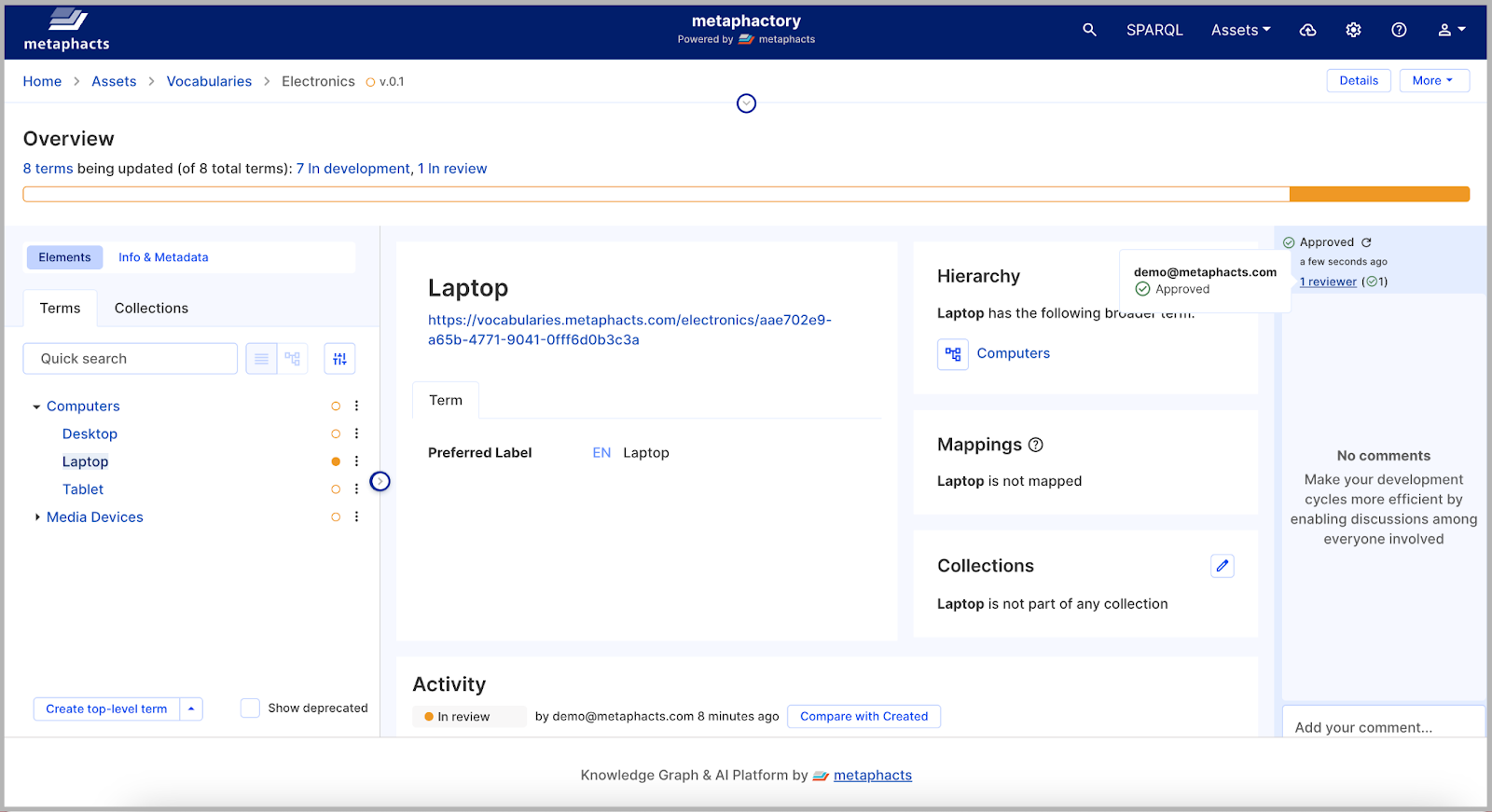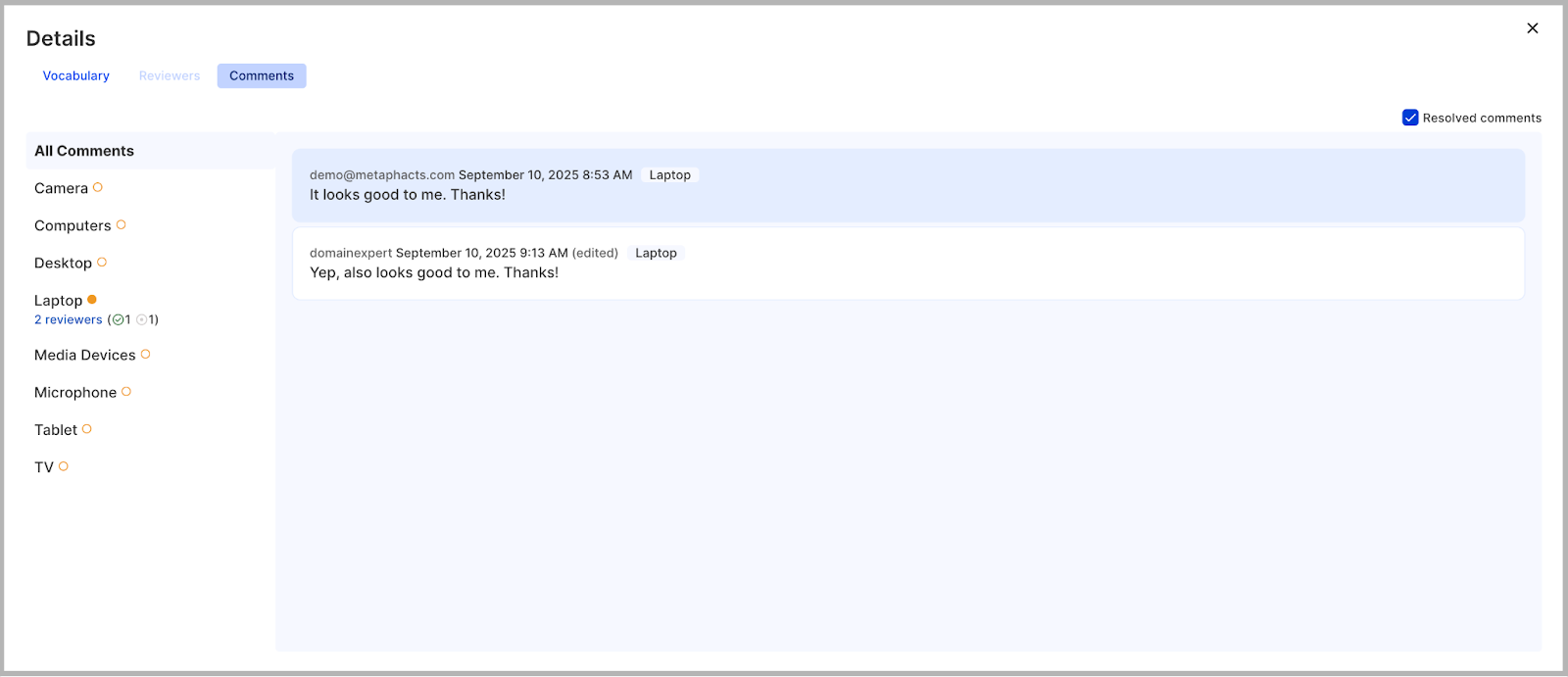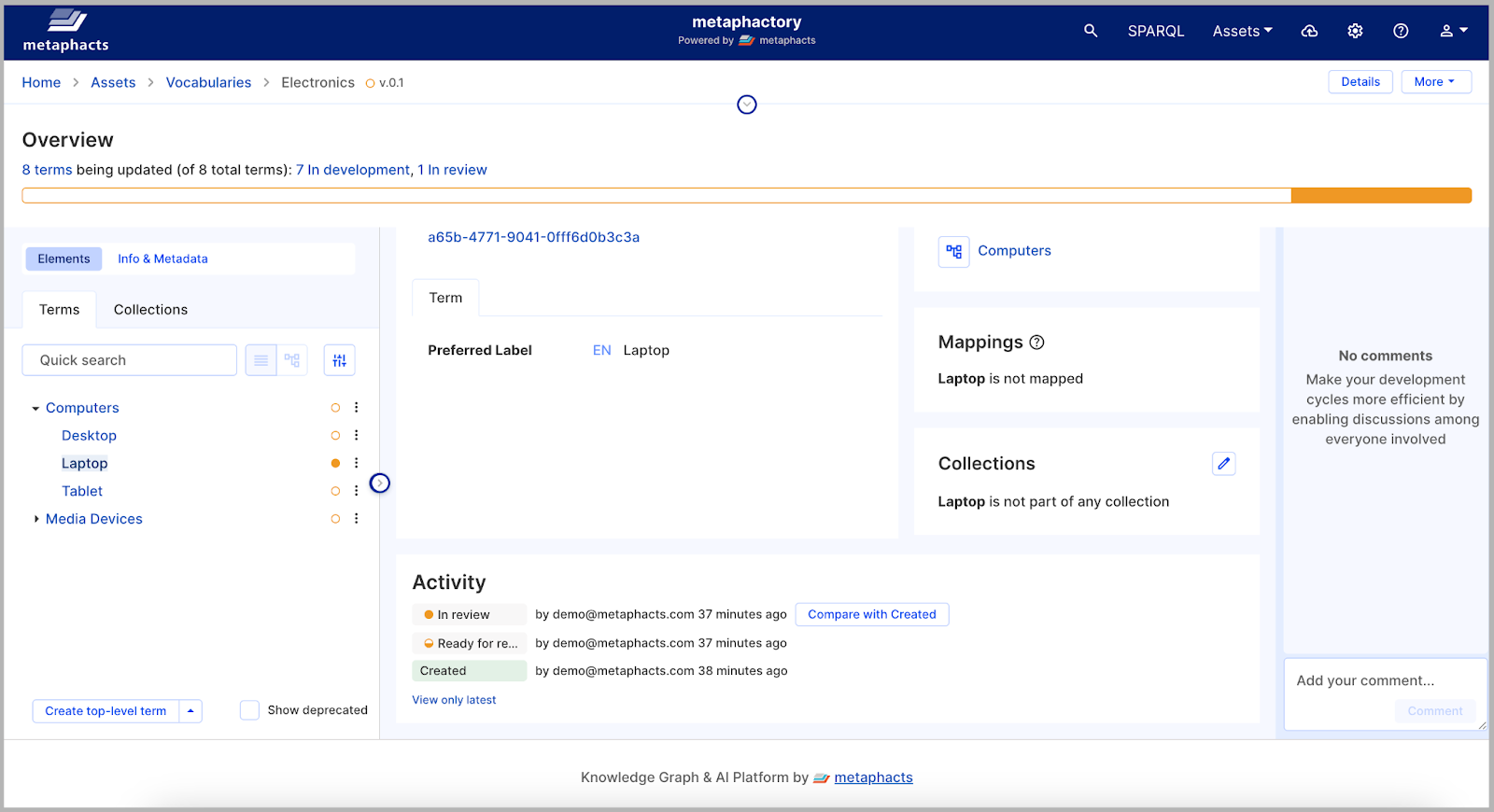In a previous article, we explored ontology governance in metaphactory. Here, we'll explore new features that enable flexible and transparent governance and editorial workflows for your vocabularies, simplifying collaboration among multiple team members. Keep reading!
Enhanced vocabulary editing and governance in metaphactory
As you may already know, semantic modeling is a highly collaborative process, one that requires coordination and collaboration among individuals of various roles, such as knowledge engineers, domain experts or business users. Capturing tacit knowledge about your business in a language that naturally reflects how objects and concepts are discussed in the real world requires contributions from a number of stakeholders who all have knowledge of different aspects of the business based on their expertise and experience, and can enrich the model with this valuable context.
In this article, we cover the improvements made to creating and managing vocabularies in metaphactory to address the evolving needs of our users and support the complexities of collaborating between multiple team members, especially as vocabulary assets grow in volume. We have enhanced the capabilities of metaphactory’s vocabulary manager by introducing an additional user workflow and new features, including partial editing, fine-grained term provenance and more. These features allow for a higher level of flexibility and transparency when building a vocabulary for your semantic model.
Keep reading to learn more about vocabulary governance in metaphactory!
Table of Contents
- The vocabulary lifecycle
- Addressing challenges in traditional vocabulary lifecycle management
- Improvements to vocabulary management in metaphactory
- Future outlook—what users may need next
- Try it for yourself
The vocabulary lifecycle
The result of a well-fleshed-out vocabulary is a consistent and shared understanding of concepts in your organization, as standardized definitions leave no room for ambiguity around regularly used terms.
Today, metaphactory facilitates two modes of editing and managing vocabularies: on the Vocabulary-level (similar to ontology editing in metaphactory) and on the Term-level (a new addition). These two modes accommodate the needs of both small teams with limited vocabularies and larger teams managing extensive vocabularies.
The term-level editorial workflow allows teams to work more flexibly on terms they are responsible for and with more transparency to avoid any miscommunications or confusion. It also tackles challenges we discovered customers with growing teams were having, including mechanisms that better support vocabulary volume, asynchronous collaboration and change communication. Before we dive into the new editorial workflow, let’s review these existing challenges.
Addressing challenges in traditional vocabulary lifecycle management
Here are some of the challenges we wanted to address with the updates to vocabulary management in metaphactory.
Scale
Depending on the organization or domain, a vocabulary can consist of anywhere from thousands to millions of terms. A large and ever-growing vocabulary can quickly become unwieldy without proper governance in place, especially since there is an iterative process to vocabulary development, requiring continuous editing, additions of new words and revisions even after publication.
Asynchronous collaboration
Many of our customers have teams working from different locations and time zones. A user editing a vocabulary term may need a review from someone on a different continent, and we needed to find a way to make this asynchronous work happen smoothly and allow individuals to make progress with their vocabulary, no matter where or when they are working on the vocabulary. From our customers, we learned that communication about edits and reviews often takes place on Slack or other messaging channels, and instead required a workflow that streamlined these discussions into the metaphactory platform directly.
Change communication
Since there are many individuals involved in developing a vocabulary, effectively communicating any changes to all relevant parties is a must. For example, in the review process, a reviewer might identify a discrepancy between a term and its synonym and must communicate this to the term author before the entire vocabulary asset enters final review. Clear change communication ensures that everyone working on the vocabulary is aligned and is sure of their next steps.
Improved collaborative vocabulary management in metaphactory
After assessing user needs, we aimed to make vocabulary editing a more seamless process in metaphactory. Overall, these functionalities are designed to improve communication among team members, provide more transparency on any changes, a clear review and approval process, and control over what is being worked on. We will go over all of these updates below.
Term-level vocabulary editing
As mentioned above, one of the significant upgrades we made to metaphactory’s vocabulary management is introducing a term-level workflow. As the name suggests, there is now an editorial workflow for individual terms, in addition to the existing vocabulary workflow. Some terms may require more editing and discussion than others, and term-level editing allows for better coordination and communication between users on a granular level, without impacting the status or progress of the vocabulary asset as a whole.

Image: Interface for term-level editing
Term-based permissions
First, we’ll go over how roles and permissions work in metaphactory’s vocabulary editor below.
Users and groups can have the following asset roles, which grant specific permissions that impact the visibility and editing of terms and assets:
-
Owner - a user with full admin rights over the vocabulary assets (including other Git operations and deletion of the vocabulary). The owner of an asset can assign other users as "authors,” which directly controls which assets a user can see and work on.
-
Author - a user who creates or edits terms or vocabulary assets (who can also designate roles and permissions for other users). Authors are granted general user-level permissions, which determine their overall ability to interact with assets across the platform.
In the vocabulary workflow, users can also take on the following roles:
-
Reviewer - authors who are responsible for reviewing and approving terms or assets
-
Contributor - authors who can create and edit terms or assets
To accept a role in the editorial workflow, a user must first ‘opt in’ to their designated asset role via their profile page, enabling them to be selected as a reviewer or contributor.

Image: User profile page where users can manage their roles
Once the roles are assigned and permissions are granted, the system displays content based on the user's role and permissions.
For example, when the entire vocabulary is in review, a user with the appropriate permissions to be an asset-level reviewer (meaning, they have opted in and are assigned to review a specific vocabulary asset) will see a top-bar form with buttons to approve or reject changes and a text space to add comments related to the vocabulary in general. A blue dot is displayed next to all terms that have been edited, so that the reviewer understands what has been changed and can conduct their review accordingly.
This makes the term-level view much more precise and focused.

Image: This image displays a vocabulary review for the "Electronics" asset. A top banner shows that a review was requested, giving the user options to approve or reject changes and leave a comment. Blue dots in the left-side panel indicate that the "Laptop" and "Tablet" terms have been updated and are pending review.
Term-based editorial states
Similar to vocabularies, individual terms within a vocabulary can have their own editorial statuses. These statuses assist in managing the editorial lifecycle of terms, from development and review to accepted for publication.
In the vocabulary dashboard, users will see a status dashboard displaying how many terms are being updated and what stages they are in, making it easy to stay on top of the overall progress of the vocabulary work and keep tabs on what is in review.
The possible statuses include:
-
In development (or deprecated): The term is in active development. Terms that have been deprecated also go back to ‘in development’.
-
Ready for review: (optional) The term is marked as ready for review by its editor.
-
In review: The term is under review by other Knowledge Graph Engineers.
-
Accepted for publication: Reviews are complete, and the term can be published.
While the vocabulary is in development and at least one term is being modified, users can see the overview of term statuses and filter to only view terms in a specific status.

Image: Vocabulary term status overview
Decisions and comments on individual terms
Terms that are in development can be edited and changed. Once in the review phase, a term is ‘locked’, meaning no further edits can be made until after a decision or approval is made. The ability to lock in on a term level allows for finer granularity and advanced workflows, where more consideration might be required. Sometimes there can be significant discussion even on one term. In this state, reviewers can offer feedback, suggest changes and submit their decisions via comments in the review sidebar associated with that specific term. If feedback needs to be addressed, the reviewer can change the term back to in development for revisions. Once the necessary changes are made and the term is moved back to in review, any existing review decisions will be cleared to allow for a new review.
While users can still add generic comments on the vocabulary level if needed, these are managed on the asset level; the core idea is that feedback on the term level is tied precisely to the term.

Image: This image displays the comments section of a vocabulary review. It shows a series of comments related to the term "Laptop," with two different users approving the changes. In the navigation on the left, yellow icons are used to highlight all terms that have associated comments.
To facilitate navigation within a vast vocabulary, especially when users are only focusing on a smaller or specific section, we provide an overview and filters. This allows users to easily select and concentrate on their assigned group of terms, ensuring an efficient and targeted review process.
Terms cannot be published individually; however, they can be moved into the ‘Accepted for publication’ status in preparation for the publication of the entire vocabulary version. Once the vocabulary version is published, all existing statuses will be cleared.
The term states and a top-bar status overview make it crystal clear what work needs to be done. Reviewers can easily see the terms being updated, in each of their different states (i.e., In development (or deprecated), Ready for review, In review, or Accepted for publication). At the same time, authors can use this bar to keep track of the status of each term of interest. This streamlined review and approval process ensures terms move forward effortlessly.
Partial reviews without locking the entire vocabulary
Another significant change we implemented as part of the term-level editorial workflow is the ability to conduct partial reviews on a vocabulary term without locking the entire asset, to allow team members working on other terms within the asset to simultaneously continue their work without any delay due to ongoing reviews. When users are in this partial review mode, every change they make is captured as an activity and made visible in the activity card.
Partial editing allows for:
-
Operating on select terms: Focus revisions or updates only on the specific terms without impacting the entire vocabulary.
-
Adding new terms in isolation: Introduce new terms to the core vocabulary and map them, without triggering a full re-validation of existing terminology.
Partial editing is beneficial for organizations with an extensive vocabulary. Let’s take, for example, a pharmaceutical company with a core vocabulary consisting of millions of terms with millions of existing mappings to public ontologies and open standards for its domain. Because of these numerous external links to other vocabularies and standards, maintaining the vocabulary has become challenging. When changes are made to a public vocabulary—be it new terms, revised definitions or deprecations—the organization also needs to update terms in its core vocabulary to maintain accurate mappings. Given the sheer scale, having to modify the entire vocabulary for every incremental change is impractical and inefficient, but with partial editing, these minor updates can be made regularly without being cumbersome or disrupting the whole workflow.
In this instance, the main vocabulary remains the central reference point or ‘source of truth’, connecting to relevant terms across these various sources, while dramatically simplifying terminology lookups and guaranteeing consistency, even when dealing with data originating from systems adhering to different standards.
Additionally, if a domain expert, perhaps a lab researcher or clinical trials manager in this case, were to identify a concept that isn’t adequately represented in the core vocabulary or the existing public ones, they can easily create a new term and also map it to relevant external sources, without requiring the entire vocabulary to undergo another review.
Fine-grained term provenance
With fine-grained term provenance, users can gain insight into a detailed history of a specific term. Each term has an activity card that includes historical tracking of any changes made, the user responsible for the change, and when the change was made.

Image: This image displays a detailed view of a vocabulary term, highlighting the Activity card. This card provides a history of the term's lifecycle, showing its creation and current "in review" status.
Fine-grained term provenance ensures all team members are aligned on the status of each term and the vocabulary asset. With this, provenance, trust and accountability are built into the workflow, as all activity on a term is made visible and each action can be traced back to a user if future clarification is needed.
Beyond internal collaboration, this detailed provenance is crucial for meeting stringent documentation and legal requirements. It enables precise tracing of data changes, providing the necessary visibility for organizations that need to meet compliance and legal requirements.
Future outlook—what users may need next
We’re eager to continue improving metaphactory’s vocabulary manager to address all customer needs and anticipate future ones. We'd love to hear what your challenges are and what you think about our future plans. Contact us to let us know your thoughts!
Try it for yourself
Are you already using metaphactory for vocabulary management? Or are you interested in getting started with vocabulary or semantic model-building in metaphactory?
Speak with one of our friendly experts to get quickly onboarded with these new updates, or discover how metaphactory can support your specific use case.
Our enterprise knowledge graph platform metaphactory delivers semantic knowledge modeling and knowledge discovery capabilities to help customers democratize and utilize knowledge across the organization. AI capabilities allow users to chat directly with the underlying data, extract trustworthy insights in context and build semantic models on the fly.


